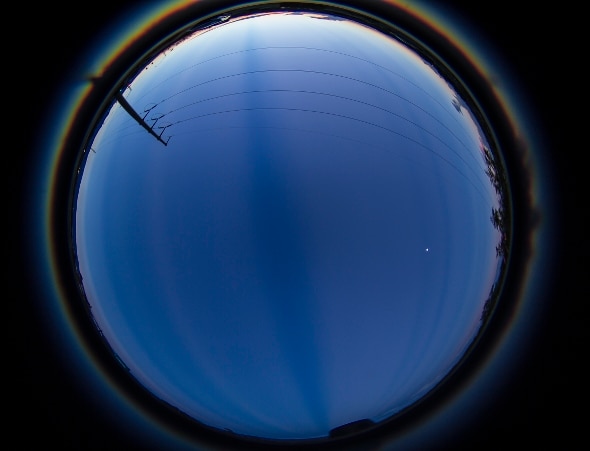Create a free profile to get unlimited access to exclusive videos, sweepstakes, and more!
Beams From the Setting Sun Cast Their Way Across the Sky

I am endlessly fascinated by phenomena in the sky, whether they occur billions of light-years away, or just above our heads. I’m not sure if that’s a byproduct of being an astronomer and looking up all the time, or if I just love all this stuff and up is the direction they happen to be in.
Either way, I’ve seen a lot of amazing things in the sky. Still, the photo above, taken by my old friend (and astronomer) Rob Sparks, took me by surprise! I don’t think I’ve ever seen anything quite like it: a wide-angle (“fish eye”) view of the sky showing one of my absolute favorite phenomena, crepuscular rays.
That’s the fancy name for the beams of light you see fanning out from the Sun, on a partially cloudy day. They are literally the shadows of clouds falling on haze or other junk floating in the air, making dark bands that interrupt the usual flow of the sunlight.
Here’s the thing, though: Even though they appear to fan out, they’re actually parallel! It’s perspective that makes them appear to diverge. At sunset, for example, the shadows start physically far away, in the air on the horizon. That can be hundreds of kilometers away, but the air overhead is only a few kilometers up. Things far away appear smaller, so the distance between the rays is small. But the part of the shadows over your head are much closer, so the distance between them is bigger. That gives them the illusion of divergence.
And it is an illusion; from space you can see the shadows are actually parallel!
But there’s more. If there are enough particles in the air, at sunset these rays can stretch a long way across the sky, and sometimes they reach all the way across. As their distance increases from you, they appear to reconverge on the horizon opposite the Sun (called the anti-solar apex). When they do this, they’re called anticrepuscular rays.
That’s what you’re seeing in Rob’s photo. The distortion added by the wide angle lens gives it an added layer of weirdness, too, especially since that one dark ray goes right through the middle, and isn’t as affected by the lens’s distortion as the ones near the horizon. In the second photo above (showing just the anticrepuscular rays as he looked east) the distortion is less, and you get the view you’d more normally see by eye.
Rob took these in Arizona on Aug. 11, when the sky was a beautiful blue, the setting Sun lit the eastern clouds magenta, and the half-full Moon hung in the sky. You might be surprised the Moon looks so small, but in reality it’s pretty small in the sky. How small it actually is might surprise you, too.
I’m glad Rob let me know about these photos; they’re lovely and interesting. He takes lots of pictures of the sky, and if you follow him on Twitter, you’ll get to see them too.
Of course, if you look up every now and again you can see this stuff for yourself. That’s a good idea, too.


























